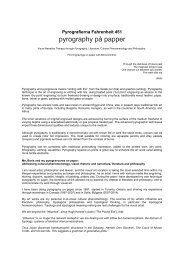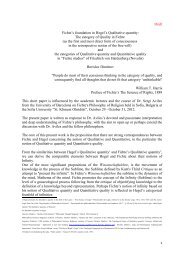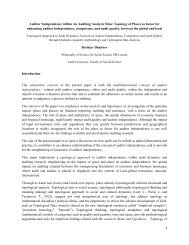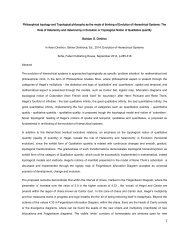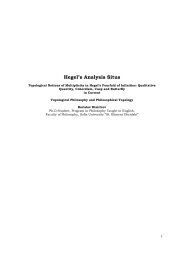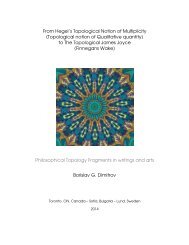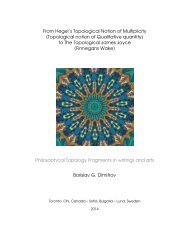Topological Ontology and Logic of Qualitative quantity
Qualitative quantity and BFO (Basic Formal Ontology) of /Barry Smith/ and YAMATO (Yet Another More Advanced Top-level Ontology) of /Riichiro Mizoguchi/
Qualitative quantity and BFO (Basic Formal Ontology) of /Barry Smith/ and YAMATO (Yet Another More Advanced Top-level Ontology) of /Riichiro Mizoguchi/
- No tags were found...
You also want an ePaper? Increase the reach of your titles
YUMPU automatically turns print PDFs into web optimized ePapers that Google loves.
Richter mentions these developments only in passing, if at all. When, in 1898, in notes for a<br />
lecture series titled "The <strong>Logic</strong> <strong>of</strong> Events" he applied Listing's topological framework to the<br />
"objective logic" <strong>of</strong> cosmological development, Peirce assumes that there is a structural<br />
similarity between the topological status I.) <strong>of</strong> a hypothesis as long as it is considered as<br />
inferred by an abductive inference, <strong>and</strong>, II.) <strong>of</strong> every more determinate state that results<br />
from the zero-state before the origin <strong>of</strong> the physical universe.First <strong>of</strong> all, both the abductive<br />
hypothesis <strong>and</strong> the more determinate state are phase transitions from states where the<br />
transformation changes the ontological modality <strong>and</strong> the dimensionality from a 0- to a 1-<br />
dimensionality.” As Pape asserts - “to put it in more traditional, though not quite adequate<br />
philosophical terms, both transformations lead from the potential to the actual. To describe<br />
this transformation in a logic <strong>of</strong> cosmological events the traditional logic <strong>of</strong> monotonic,<br />
deductive necessary inferences was neither possible nor adequate because it would have<br />
required giving the possibility <strong>of</strong> a logical connection between the state <strong>of</strong> unrestricted<br />
indeterminacy <strong>and</strong> any more determinate state.” 73<br />
Let us see the background <strong>of</strong> the topological turn in Peirce.<br />
Topology is the study <strong>of</strong> continuity <strong>and</strong> connectivity, it is concerned with properties that are<br />
preserved under continuous deformations <strong>of</strong> objects, such as deformations that involve<br />
stretching, but no tearing or gluing. Topology emerged through the development <strong>of</strong><br />
concepts from geometry <strong>and</strong> set theory, such as space, dimension, <strong>and</strong> transformation.<br />
Leonhard Euler's 1736 paper on the Seven Bridges <strong>of</strong> Koningsberg is regarded as one <strong>of</strong> the<br />
first academic treatises in modern topology. In 1847 Johan Benedict Listing first introduced<br />
the term "Topologie" in German with his Vorstudien zur Topologie. Listing had used the<br />
word topology for ten years in correspondence before its first appearance in print.<br />
"Topology," its English form, was first used in 1883 in Listing's obituary in the journal<br />
Nature to distinguish "qualitative geometry from the ordinary geometry in which<br />
quantitative relations chiefly are treated". Johan Benedict Listing (independently) discovered<br />
the properties <strong>of</strong> the half-twisted strip at the same time as August Ferdin<strong>and</strong> Mobius. In<br />
1895 Henri Poincare, published his Analysis situs introducing the concept <strong>of</strong> homotopy <strong>and</strong><br />
homology, as part <strong>of</strong> topology.<br />
And here is Helmut Pape account on the development <strong>of</strong> the <strong>Topological</strong> Peirce:<br />
"Only late in his life Peirce become aware <strong>of</strong> what peculiar meta-logical <strong>and</strong> topological<br />
properties an adequate account <strong>of</strong> hypothetical inference has to deal with <strong>and</strong> the decisive<br />
experience was his formulation <strong>of</strong> a logic-based evolutionary metaphysics from 1890-93.<br />
By 1898, when Peirce planned to give a lecture-series at Harvard on his evolutionary<br />
metaphysics, the title "The Consequences <strong>of</strong> Mathematics" or "The <strong>Logic</strong> <strong>of</strong> Events" reflects a<br />
change in the style <strong>of</strong> reasoning: To some extent the biological, evolutionary, physiological<br />
<strong>and</strong> psychological concepts <strong>of</strong> the 1891 version <strong>of</strong> his evolutionary metaphysics were either<br />
replaced or interpreted by logical <strong>and</strong> mathematical notions. In particular he applied <strong>and</strong><br />
developed topological concepts - adapted from early topology by Benedict Listing [1862] -<br />
to the cosmological development <strong>of</strong> an ontological phase transition necessary to initiate<br />
cosmology evolution." 74<br />
"This ontological transformation is not only described as a hypothetic inference but is<br />
described in the language <strong>of</strong> topological conditions for changes in <strong>and</strong> between dimensions<br />
<strong>of</strong> shape. Peirce describes singularities by the restriction in the type <strong>of</strong> movement in which a<br />
singular point or line can be reached or transformed. He constructs his description for the<br />
layout <strong>and</strong> the changes in the zero-state <strong>of</strong> cosmological development, which is a state <strong>of</strong><br />
73 Helmut Pape, "Abduction <strong>and</strong> the Topology <strong>of</strong> Human Cognition"<br />
74<br />
Ibid.<br />
35





